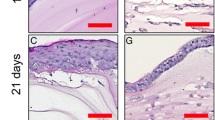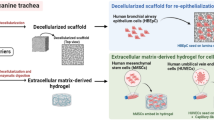Abstract
Fibrin gel has proven a valuable scaffold for tissue engineering. Complex geometries can be produced by injection molding; it offers effective cell seeding and can be produced autologous. In order to evaluate its suitability for respiratory tissue engineering, we examined proliferation, functionality, and differentiation of respiratory epithelial cells on fibrin gel in comparison to culture on collagen-coated, microporous membranes. Respiratory epithelial cells formed a confluent layer by day 4, and proliferation showed no significant difference with respect to surface. Measurement of the transepithelial electrical resistance reflected the development of a confluent epithelial cell layer and the subsequent initiation of adequate ion-transfer processes. Appearance of ciliae could be detected at similar time points, and ciliary beating could be observed for cells on both surfaces. Histology and immunohistochemistry of cells grown on fibrin gel revealed the onset of adequate differentiation. As no significant differences in respiratory epithelial cells’ proliferation, function, and differentiation could be observed between cells grown on fibrin gel compared to cells on a collagen-coated, microporous surface, we concluded that fibrin gel might prove a suitable scaffold for respiratory tissue engineering and merits further investigation to overcome the limitations associated with scaffolds currently in use.







Similar content being viewed by others
References
Ahmed, T. A, E. V. Dare, M. T. Hincke. Fibrin: a versatile scaffold for tissue engineering applications. Tissue Eng. B Rev. 14:199–215, 2008 [Epub ahead of print].
Bader, A., T. Schilling, O. E. Teebken, G. Brandes, T. Herden, G. Steinhoff, and A. Haverich. Tissue engineering of heart valves—human endothelial cell seeding of detergent acellularized porcine valves. Eur. J. Cardiothorac. Surg. 14(3):279–284, 1998.
Coleman, D. L., I. K. Tuet, and J. H. Widdicombe. Electrical properties of dog tracheal epithelial cells grown in monolayer culture. Am. J. Physiol. 246:C335–C359, 1984.
Ferguson, D. I., I. J. Wild, and O. H. Wangensteen. Experimental resection of the trachea. Surgery 28:597–619, 1950.
Flanagan, T. C., C. Cornelissen, S. Koch, B. Tschoeke, J. S. Sachweh, T. Schmitz-Rode, and S. Jockenhoevel. The in vitro development of autologous fibrin-based tissue-engineered heart valves through optimised dynamic conditioning. Biomaterials 28:3388, 2007.
Galler, K. M., A. C. Cavender, U. Koeklue, L. J. Suggs, G. Schmalz, and R. N. D’Souza. Bioengineering of dental stem cells in a PEGylated fibrin gel. Regen. Med. 6(2):191–200, 2011.
Hildebrandt, F., T. Benzing, and N. Katsanis. Ciliopathies. N. Engl. J. Med. 364(16):1533–1543, 2011.
Jockenhoevel, S., K. Chalabi, J. S. Sachweh, H. V. Groesdonk, L. Demircan, M. Grossmann, G. Zund, and B. J. Messmer. Tissue engineering: complete autologous valve conduit—a new moulding technique. Thorac. Cardiovasc. Surg. 49(5):287–290, 2001.
Koch, S., T. C. Flanagan, J. S. Sachweh, F. Tanios, H. Schnoering, T. Deichmann, V. Ellä, M. Kellomäki, N. Gronloh, T. Gries, R. Tolba, T. Schmitz-Rode, and S. Jockenhoevel. Fibrin-polylactide-based tissue-engineered vascular graft in the arterial circulation. Biomaterials 31(17):4731–4739, 2010.
Kucera, K. A., A. E. Doss, S. S. Dunn, L. A. Clemson, and J. B. Zwischenberger. Tracheal replacements: part 1. ASAIO J. 53:497–505, 2007.
Macchiarini, P., P. Jungebluth, T. Go, M. A. Asnaghi, L. E. Rees, T. A. Cogan, A. Dodson, J. Martorell, S. Bellini, P. P. Parnigotto, S. C. Dickinson, A. P. Hollander, S. Mantero, M. T. Conconi, and M. A. Birchall. Clinical transplantation of a tissue-engineered airway. Lancet 372:2023–2030, 2008.
Matloub, H. S., and P. Yu. Engineering a composite neotrachea in a rat model. Plast. Reconstr. Surg. 117(1):123–128, 2006.
Mol, A., C. V. Bouten, F. P. Baaijens, G. Zünd, M. I. Turina, and S. P. Hoerstrup. Review article: tissue engineering of semilunar heart valves: current status and future developments. J. Heart Valve Dis. 13(2):272–280, 2004.
Park, S. H., B. H. Choi, S. R. Park, and B. H. Min. Chondrogenesis of rabbit mesenchymal stemcells in fibrin/hyaluronan composite scaffold in vitro. Tissue Eng. A 17(9-10):1277–1286, 2011.
Sodian, R., M. Loebe, A. Hein, D. P. Martin, S. P. Hoerstrup, E. V. Potapov, H. Hausmann, T. Lueth, and R. Hetzer. Application of stereolithography for scaffold fabrication for tissue engineered heart valves. ASAIO J. 48(1):12–16, 2002.
Stock, U. A., J. P. Vacanti, J. E. Mayer, Jr, and T. Wahlers. Tissue engineering of heart valves—current aspects. Thorac. Cardiovasc. Surg. 50(3):184–193, 2002.
Widdicombe, J. H., A. S. Lorne, L. M. Joby, and E. F. Walter. Expansion of cultures of human tracheal epithelium with maintenance of differentiated structure and function. Biotechniques 39:249–255, 2005.
Yamaya, M., W. E. Finkbeiner, S. Y. Chun, and J. H. Widdicombe. Differentiated structure and function of cultures from human tracheal epithelium. Am. J. Physiol. 262:L713–L724, 1992.
Zhao, F., Y. Zhang, S. Liu, and J. Yu. Artificial trachea reconstruction with two-stage approach using memory-alloy mesh. Chin. Med. J. (Engl) 116(12):1949–1951, 2003.
Acknowledgments
This study was supported by a grant from the START program of the Medical Faculty of the RWTH Aachen University.
Conflict of interest
The authors declare that they have no competing financial or other interests.
Author information
Authors and Affiliations
Corresponding author
Additional information
Associate Editor Jennifer West oversaw the review of this article.
Electronic supplementary material
Below is the link to the electronic supplementary material.
Supplementary material 1 (AVI 15588 kb)
Supplementary material 2 (AVI 29199 kb)
Rights and permissions
About this article
Cite this article
Cornelissen, C.G., Dietrich, M., Krüger, S. et al. Fibrin Gel as Alternative Scaffold for Respiratory Tissue Engineering. Ann Biomed Eng 40, 679–687 (2012). https://doi.org/10.1007/s10439-011-0437-8
Received:
Accepted:
Published:
Issue Date:
DOI: https://doi.org/10.1007/s10439-011-0437-8




